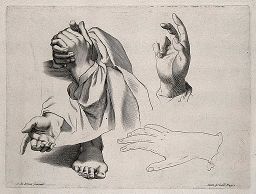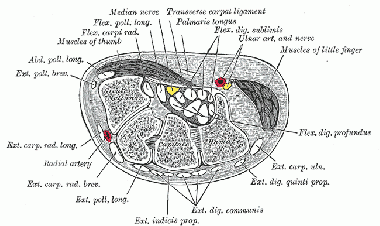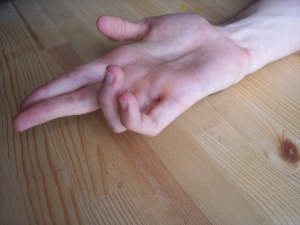Benediction Hand (aka Benediction Sign or Preacher's Hand): Difference between revisions
mNo edit summary |
(added image, categories, links, edited text and resources link.) |
||
| Line 3: | Line 3: | ||
'''Top Contributors''' - {{Special:Contributors/{{FULLPAGENAME}}}} | '''Top Contributors''' - {{Special:Contributors/{{FULLPAGENAME}}}} | ||
</div> | </div> | ||
[[File:Benediction hand.jpg|center|thumb|256x256px|Benediction hand | |||
https://wellcomeimages.org/indexplus/obf_images/e4/9e/1312af2f698fda45eebcf9cd4af8.jpg | |||
]] | |||
== Description == | |||
The Benediction Sign is the result of a peripheral neuropathy affecting musculature in the hand. It is seen when the patient is asked to make a fist and the ring and little finger flex but the index and middle finger can't flex at the metacarpal-phalangeal joint or interphalangeal joint. | |||
There is some controversy as to the source of the Benediction Sign for many years, specifically if the median nerve or the ulnar nerve is involved<ref name="Futterman" />. According to Futterman, <ref name="Futterman">Futterman B. Analysis of the Papal Benediction Sign: The ulnar neuropathy of St. Peter. Clin Anat. 2015 Sep;28(6):696-701.</ref> the desired position of the hand during a blessing or benediction would typically have been an open position with the fingers extended. In fact, he notes that the 4th and 5th digits would have been abducted from the second and third digits (similar to the hand sign used by Vulcans in the Star Trek TV and movie series). <ref name="Futterman" /> Based on this author's research of cultural artwork, he asserts that Peter, the first Pope, had an ulnar neuropathy which limited Peter's ability to perform the then-traditional open hand blessing and has led to the hand position that has since become the norm for giving blessings.<ref name="Futterman" /><br> | |||
In the presence of an [[Ulnar Nerve Entrapment|ulnar neuropathy]], function of the interossei and lumbrical muscles to the 4th and 5th digits would be compromised, thus the 4th and 5th digits could not abduct from the midline of the hand (interossei function) nor could those fingers flex at the MCP joints or extend at the IP joints (lumbrical function). Extensor digitorum (innervated by the radial nerve) acts primarily on the MCP joint, not the IP joints, therefore it could not extend the IP joints to compensate for loss of lumbrical function. <ref>https://en.wikipedia.org/wiki/Extensor_digitorum_muscle. Last accessed 13 02 2016.</ref> As a result, during an attempt to extend the 4th and 5th digits (as in the open hand blessing described above) the MCP joints be extended but the IP joints would stay flexed. <br> | |||
<br> | Futterman <ref name="Futterman" /> notes that Benediction Sign is often described as a median nerve injury because this would result in an inability to perform flexion at the MCP and IP joints of the 2nd and 3rd digits. However, he notes that this would only make sense if the injured person was trying to make a fist and since a fist is not a historically-known sign of blessing or greeting, Benediction Sign must stem from an ulnar neuropathy and the subsequent inability to fully open the hand. <br> | ||
== Clinically relevant anatomy == | |||
{| width="100%" cellspacing="1" cellpadding="1" | {| width="100%" cellspacing="1" cellpadding="1" | ||
|- | |- | ||
| [[Image:Interactive hand - hand - L17F1.jpg|left|380px]] | | [[Image:Interactive hand - hand - L17F1.jpg|left|380px]] | ||
| [[Image:Transerve section hand at wrist and digits.gif|left|380px]] | | [[Image:Transerve section hand at wrist and digits.gif|left|380px| | ||
Transerve section hand at wrist and digit | |||
]] | |||
|} | |} | ||
<br> | |||
== Clinical Presentation == | == Clinical Presentation == | ||
[[Image:Benediction hand ulnar claw.JPG|center|300px]] | [[Image:Benediction hand ulnar claw.JPG|center|300px]] | ||
== | == Resources == | ||
<br>[http://teachmeanatomy.info/upper-limb/nerves/ulnar-claw-vs-hand-of-benediction/ The Ulnar Nerve Anatomy]<br> | |||
== References == | == References == | ||
| Line 63: | Line 41: | ||
<br> | <br> | ||
[[Category:Neurological_Conditions]] [[Category:Musculoskeletal/Orthopaedics]] | [[Category:Neurological_Conditions]] | ||
[[Category:Musculoskeletal/Orthopaedics]] | |||
[[Category:Neuropathy]] | |||
[[Category:Hand]] | |||
Revision as of 23:06, 12 March 2019
Original Editor -Pamela Gonzalez
Top Contributors - Laura Ritchie, Aminat Abolade, Kirenga Bamurange Liliane, Kim Jackson, Admin, Pamela Gonzalez, Rachael Lowe, David Adamson, WikiSysop, Lauren Kwant, Evan Thomas and Richard Benes
Description[edit | edit source]
The Benediction Sign is the result of a peripheral neuropathy affecting musculature in the hand. It is seen when the patient is asked to make a fist and the ring and little finger flex but the index and middle finger can't flex at the metacarpal-phalangeal joint or interphalangeal joint.
There is some controversy as to the source of the Benediction Sign for many years, specifically if the median nerve or the ulnar nerve is involved[1]. According to Futterman, [1] the desired position of the hand during a blessing or benediction would typically have been an open position with the fingers extended. In fact, he notes that the 4th and 5th digits would have been abducted from the second and third digits (similar to the hand sign used by Vulcans in the Star Trek TV and movie series). [1] Based on this author's research of cultural artwork, he asserts that Peter, the first Pope, had an ulnar neuropathy which limited Peter's ability to perform the then-traditional open hand blessing and has led to the hand position that has since become the norm for giving blessings.[1]
In the presence of an ulnar neuropathy, function of the interossei and lumbrical muscles to the 4th and 5th digits would be compromised, thus the 4th and 5th digits could not abduct from the midline of the hand (interossei function) nor could those fingers flex at the MCP joints or extend at the IP joints (lumbrical function). Extensor digitorum (innervated by the radial nerve) acts primarily on the MCP joint, not the IP joints, therefore it could not extend the IP joints to compensate for loss of lumbrical function. [2] As a result, during an attempt to extend the 4th and 5th digits (as in the open hand blessing described above) the MCP joints be extended but the IP joints would stay flexed.
Futterman [1] notes that Benediction Sign is often described as a median nerve injury because this would result in an inability to perform flexion at the MCP and IP joints of the 2nd and 3rd digits. However, he notes that this would only make sense if the injured person was trying to make a fist and since a fist is not a historically-known sign of blessing or greeting, Benediction Sign must stem from an ulnar neuropathy and the subsequent inability to fully open the hand.
Clinically relevant anatomy[edit | edit source]
Clinical Presentation[edit | edit source]
Resources[edit | edit source]
References[edit | edit source]









